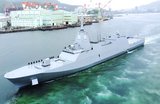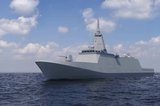LRASM MK 41 VLS testing successfully completed
A simulated Long Range Anti-Ship Missile (LRASM) has sucessfully undergone MK 41 Vertical Launch System (VLS) 'push-through' testing, Lockheed Martin reported on 3 June. The testing is part of the company's shipboard integration effort to prove LRASM can successfully function as an Offensive Anti-Surface Warfare (OASuW) weapon.
The four consecutive tests verified that the LRASM can break through the MK 41 canister's forward cover without causing damage to the composite structure, air data probe or coatings of the missile. This form of testing is an important risk reduction milestone in the programme to demonstrate the missile's surface launch capabilities.
LRASM is an autonomous, precision-guided anti-ship standoff missile being designed tomeet the needs of the US Navy and Air Force. The development of the missile builds on the successful Joint Air-to-Surface Standoff Missile Extended Range (JASSM-ER). The missile is in development by Lockheed Martin with the Defense Advanced Research Projects Agency (DARPA) and the Office of Naval Research.
LRASM cruises autonomously, day or night, in all weather conditions, armed with a proven penetrator and blast-fragmentation warhead. The missile employs a multi-modal sensor, weapon data link and an enhanced digital anti-jam Global Positioning System to detect and destroy specific targets within a group of ships. Both surface-launched and air-launched variants are planned to prosecute sea-based targets at significant standoff ranges.
Scott Callaway, LRASM surface launch program manager, Lockheed Martin Missiles and Fire Control, said: 'These test results verified that the LRASM vehicle can break through the VLS cover without damage at realistic flight speeds. Lockheed Martin is investing in the shipboard integration of LRASM and we are confident it will meet all the requirements for the US Navy.'
Later this year a Boosted Test Vehicle (BTV) version of LRASM will be launched from a MK 41 VLS platform, which will be followed by two government-funded Controlled Test Vehicle flights in 2014.
More from Naval Warfare
-
![NATO tests use of “undetectable, jam-proof” laser communication in maritime scenarios]()
NATO tests use of “undetectable, jam-proof” laser communication in maritime scenarios
As part of its effort to better prepare its capabilities for operations in contested and congested scenarios, NATO evaluated a Lithuanian ship-to-ship terminal designed to not be susceptible to enemy interference.
-
![Future of the Canadian Patrol Submarine Project is still unclear]()
Future of the Canadian Patrol Submarine Project is still unclear
The Canadian government remains tight-lipped on the timeline and funding required for the next steps of its Canadian Submarine Patrol Project, which should offer improved capabilities for the country’s navy.
-
![Mitsubishi eyes future with Australia’s Mogami selection]()
Mitsubishi eyes future with Australia’s Mogami selection
With Australia’s selection of the Mogami-class for Project Sea 3000, Mitsubishi is investigating local production in the next decade as potential export opportunities emerge.
-
![Thales’ new Sonar 76Nano could equip UK Royal Navy on anti-submarine warfare missions]()
Thales’ new Sonar 76Nano could equip UK Royal Navy on anti-submarine warfare missions
The new sonar is designed to equip uncrewed underwater vessels, with the potential to be used by the Royal Navy for its Atlantic Bastion and Atlantic Net missions.























